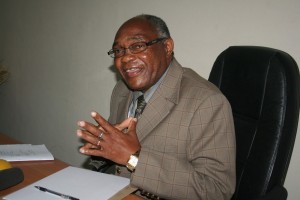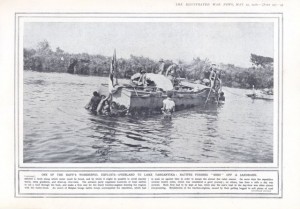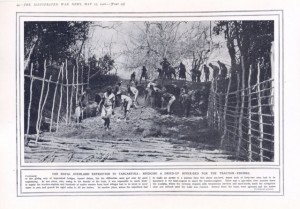Edited by John Cooper-Poole
SERENGETI STORY: LIFE AND SCIENCE IN THE WORLD’S GREATEST WILDLIFE REGION. Anthony R.E. Sinclair. Oxford University Press, 270 pp. ISBN 978-0-19-964552-7. £18.99/$34.99
Most people interested in African savannah ecosystems, and the Serengeti in particular, will be familiar with the scientific work of Anthony (Tony) Sinclair. As the author of hundreds of influential research papers and seven major scientific books, his life-long research has left a permanent imprint on the discipline of ecosystem ecology, and possibly more importantly, on the face of the planet. In Serengeti Story, Tony Sinclair traces the history of this 30,000 km² World Heritage Site from his arrival in 1965 to the present, laced with personal experiences of great joy and disaster, scientific perspectives on the past health of the ecosystem, and the challenges faced by this vast expanse of wildlife-friendly terrain under constant threat from resource exploitation, agricultural conversion, herders and poachers.
Sinclair provides an accessible, fascinating and illustrated history of the people and animal populations of this region. Few of the processes controlling its biodiversity and ecological systems were understood until the second half of the 20th century, and much of this understanding is due to Sinclair, his students and his collaborators. Included are chapters on the early wildlife ecologists -the likes of George Schaller of the Wildlife Conservation Society, who first described the social lives of lions; and Han Kruuk who did the first study of wild hyenas. He includes a number of portraits of his successful research students (now collaborators) and his record of supporting Tanzanian researchers is admirable.
He recounts the various disasters, shortages and blocks to East African field research that were regularly encountered due to political upheavals such as those in Uganda, border closures in the East African Community, banditry and routine breakdowns of aircraft and cars. Some of these stories are very funny, others are tragic, but all are told with Sinclair’s honest and elegant prose. And each human story is matched with information about the bird and mammal species of the Serengeti, uniquely known to Sinclair.
Serengeti’s story does not yet have a happy ending. While dedicated ecologists such as Sinclair have made a life’s work out of unravelling the complex dynamics and interactions sustaining this vital ecosystem, what they all have shown is how vulnerable it is to human activities. Predator die-offs due to distemper from local dogs, retaliatory hunting and poisoning, threats from ivory and meat poaching, fires and the increasing frequency of droughts, and most recently the proposal for a highway to enable mining and settlements that will cut the renowned wildebeest migration in half.
In June 2013, the funding for this road was approved by the Tanzanian Parliament and thus it will probably go ahead. It appears that no part of the globe is immune from the interests of development, even World Heritage Sites like Serengeti that provide considerable revenues through their intact ecosystem functioning. The voice of campaigners, scientists, local conservationists and the long-term studies of Sinclair and colleagues may ultimately be for naught.
P.C. Lee
Phyllis Lee has studied wildlife biology in East Africa since 1975, and is currently the Director of Science for the Amboseli Trust for Elephants, as well as Professor at the University of Stirling, U.K.
TRANSLATING GROWTH INTO POVERTY REDUCTION BEYOND THE NUMBERS Edited by Flora Kessy, Oswald Mashindano, Andrew Shepherd and Lucy Scott 2013. Mkuki na Nyota: Dar es Salaam. 226 pages. ISBN 978-9987-08-226-1. Available from African Books Collective Ltd., P.O. Box 721, Oxford OX1 9EN (paperback).
A book with four respected academic editors and thirteen contributors devoted to poverty reduction in a third world country is bound to appeal to a wide readership. The work of the Chronic Poverty Research Centre might not at first appear of interest to the casual reader, but the many interviews of the rural poor are fascinating to anyone who has experienced travel in the non-urban parts of Tanzania. This well referenced book can be recommended as a valuable source of information about Tanzania, where economic growth has averaged seven per cent between 2000 and 2008 but poverty has stubbornly failed to make any such dramatic improvement. This is at a time of stable government and exploitation of many forms of natural resources.
Small farms (shambas) often do not thrive and secondary education is one of the best ways for children to escape rural poverty; but it often only leads, at best, to employment in the service industry in towns. However, those employed in urban areas, such as security guards, will remit money to support families in rural communities.
Chapter 4 on the Rise of Womens’ Responsibility also gives hope as it is suggested that a quarter of households are woman-led. Yet divorce and (male) alcoholism are cited as causes of women falling into poverty. Inheritance laws (including customary law) do not always favour the retention of viable shambas and polygamy is another problem. Education at primary level is available for all, but the route for women to escape poverty is not easy. A recent research paper, Boys v Girls Maths performance in Africa, analysed secondary school results and found that Tanzania has the worst record of the 19 countries monitored for girls doing worse than boys at government examinations.
Increasing cross border trade is suggested as one possible means by which agricultural products could be more profitable. However, the friendship bridge Mtambashwala, between Mtwara region and Mozambique, opened in the last year, has not brought immediate benefits. Farming remains the largest work sector and the sale of plant products averaged 26 per cent of GDP. The livestock industry, unlike that of neighbouring Zambia, has never developed a significant export trade and will not do so until road and rail links are more reliable.
Dick Lane
Dick Lane worked as a veterinary surgeon in Africa in the early 50’s and since 2002 has been a frequent visitor to rural Tanzania. Having been awarded a Fellowship of the Royal Agricultural Societies, he has an interest in all farming matters, economics and is studying for an MSc involving animal welfare. He is a trustee of the registered charity African Sisters (CMM) Support Group, which helps the Anglican Sisters in Tanzania and Zambia.
ASPECTS OF COLONIAL TANZANIA HISTORY. Lawrence E. Y. Mbogoni and Mkuki na Nyota, Dar es Salaam. 2013. Pp. 211. US$24.95, paper (ISBN 9789987083008). Available from African Books Collective.
The Tanzania-born and America-based historian Lawrence Mbogoni has produced a delightful and eclectic collection of essays on colonial life in Tanzania. His starting point is the central distinction between coloniser and colonised, and how this conceit plays out in diverse forums, from the airy realms of ‘civilisation’ discourse to grubby conflicts over land and money. Divided into four sections – ‘Economy and Politics in Tanganyika’; ‘Film Production and Radio Broadcasting’; ‘Affairs of the Heart in Colonial Zanzibar’; and ‘Slavery and Politics in Colonial Zanzibar’ – this collection is not framed around current academic debates on the meanings of colonialism, but rather offers a study of institutions and emotions.
Loneliness, avarice, fear, depravity, and jealousy animate the actions of eccentric European adventurers who come to colonial Tanganyika to strike it rich in diverse locales such as the Lupa goldfields or the game-hunting savannahs. Mbogoni has a particularly sharp eye for European debauchery, be it in the spreading of venereal diseases through interracial liaisons, or in the excessive drinking that leads to territory-wide alcohol restrictions. As a result, each of the book’s eleven chapters rarely fails to entertain.
The first section’s overriding topic is the hypocritical unaccountability of colonial legal structures, which the author shows can take many forms. In the experience of the colourful poacher-turned-gamekeeper George Gilman Rushby, conservation laws and institutions pliably bend to meet European convenience. In the case of Chief Makongoro of Ikizu, the institution of indirect rule allows an ambitious chief to build up enormous wealth and patronage, until administrators decide that patronage is in fact corruption, deposing Makongoro and sending him off to an exile which he does not long survive.
Mbogoni also explores a famous 1955 murder case of the Arusha-based settler Harold Stuchbery at the hands of a local Maasai man. The subsequent criminal trial ended in acquittal, but for the Maasai the real legal process is offering ‘blood money’ to compensate Stuchbery’s survivors, in which the animating principle is not guilt or innocence but balance.
Throughout the book, the main sources are classically colonial—and British colonial at that, as German-era materials are not consulted. European memoirs loom large, as do the reports and legislation of the British colonial government. The bibliography is a bit sparse but the footnoting is generous, revealing the paradoxical nature of the book’s sources—mostly drawn from ‘metropolitan’ archives and libraries, with almost none having a physical home in Tanzania.
Narrative regularly trumps academic-style structuring in each chapter, with introductions and conclusions employed primarily to set up stories rather than elaborate analyses. Yet Mbogoni does bring in relevant secondary literature on Tanzanian and African history to illustrate wider contexts. The defining role of colonial racism and the (failed) attempts to impose cultural hegemony are phrased briefly, flatly, and without any jargon-strewn prose.
In the second section, Mbogoni offers an overview of Tanganyika’s colonial cinema and reveals the logistical nightmares that Hollywood productions navigated in late colonial East Africa. The most original chapter in historiographical terms concerns radio, with a much-needed survey of colonial-era broadcasting. Colonial radio was dominated by the government’s Public Relations Department and one key manager seconded from the BBC, Tom Chalmers, yet Mbogoni does not offer much interpretively about the legacy of Radio Dar es Salaam and the Tanganyika Broadcasting Corporation for Tanzania.
The most surprising chapter concerns the illicit relationship between a British colonial doctor, Henry Watkins-Pitchford, and a young teenage Parsi girl in Zanzibar, a tale preserved in voyeuristic detail in the U.K. National Archives. More familiar is the case of the Zanzibari ‘Princess’ Seyyida Salme and Heinrich Ruete—a story which Mbogoni ably synthesizes, while adding his own somewhat wooden speculations on the lasting religious impact of Islamic education on the exiled Zanzibari widow.
The concluding chapters on the legacy of slavery in Zanzibari politics covers well-trodden ground, and unfortunately takes at face value the islands’ racial categories and the orientalist fantasies of European travel writers. The book’s general lack of source criticism and specific historiographical intervention is most sorely felt in this final section, which will satisfy few readers interested in Zanzibari history. Yet this does not detract from the larger portrait, painted in a novel combination of brushstrokes that highlight the relationship between the institutions and psychologies of colonial-era life.
James R. Brennan
Dr James Brennan is currently at University of Illinois at Urbana-Champaign U.S.A. He is author of the book Taifa; Making Nation and Race in Urban Tanzania (Reviewed in Tanzanian Affairs No 104)
WORLD WAR I IN AFRICA: THE FORGOTTEN CONFLICT AMONG THE EUROPEAN POWERS; Anne Samson, : I. B. Tauris, London 2013 306 pages, ISBN 978 1 78076 119 0. £59.50.
Anne Samson’s World War I in Africa: The Forgotten Conflict among the European Powers is a welcome addition to the literature on the 1914-18 War. Each decade tends to bring at least one new title on the conflict, and following the earlier works of Byron Farwell and Melvin Page, and the memorable 1978 special issue of the Journal of African History, we have recently had books by Ross Anderson, Giles Foden, Edward Paice and, Huw Strachan and John Morrow with his The Great War: An Imperial History.
Despite these important works, the European aspect of the conflict is so programmed in to the Western DNA that non-European theatres need all the publicity they can get. What is pleasing about this addition is that it looks up and down the scale, from high politics and strategy to operations on the ground, rather than a particular region (East Africa being the usual candidate) or episode (such as the dispatch of gunboats to the inland lakes). Though heavily focused on eastern and southern Africa, it provides a continent-wide narrative of the campaigns, linking their conduct to local and imperial level politics and examining the interrelatedness of policy and strategy with what was happening on the ground.
The book also offers a blended perspective that brings the Belgians and the Portuguese alongside the British and the Germans. Whilst not a military history, the volume covers the war on land, sea and in the air, with a whole chapter devoted to the war in the air, at sea and on the inland lakes, where gunboats fought and across which troops were ferried.
The book reflects Dr Samson’s expertise as a South African historian; the war in West Africa is entirely subsidiary here, as is the war north of the Sahara.
The author’s review of the situation on the eve of the war does not do a great deal for the book’s war focus, the outbreak of war not occurring until page sixty-eight. There are useful tables of key events and personalities, as well as seventeen rather dreary black and white photos. There is an attempt throughout to examine the impact of key personalities, such as Jan Smuts and Paul Von Lettow-Vorbeck, adding a rather traditional ‘great man’ sheen to the account.
The view from Whitehall is fully explored, as is the question of what the European belligerents with African holdings actually sought to achieve. All told, this is an original and important contribution to the literature on the war in Africa. But it is not definitive; it touches lightly on issues that warrant significant further research,such as logistics, and it is avowedly not an African history of the war, but of the conflict Europe brought to Africa.
Ashley Jackson
Ashley Jackson is Professor of Imperial and Military History at King’s College, London
THE WICKED WALK. By W.E. Mkufya. Mkuti na Nyota Publishers, Tanzania. 2012. ISBN 9789987082032. p/b 118 pages. £15.95. Available from African Books Collective.
Maria detests her life as a prostitute but sees no other way of earning the money she needs to support herself and her daughter Nancy, a form 4 secondary school student. She desperately desires a better life for her daughter, but feels powerless in seeing Nancy swept along in an ‘evil’ current and pursued by the unsavoury Magege, manager at the local rubber factory. Magege is unscrupulous, corrupt and greedy with a taste for young school girls, Nancy included. Nancy very soon realises her power as a woman who can make “easy” money from selling sex and decides to quit school where she has a promising academic future ahead of her.
Deo is dating Nancy and is told by a colleague at the factory that she is “seeing” Magege behind his back, but he doesn’t want to believe it. Eventually he is forced to face the truth and breaks off his engagement to her. Much of the narrative focuses on the state of society – inequality, injustice and especially how “sugar daddies” like Magege seem to get away with their immoral behaviour. Hence the title, drawn from the Book of Psalms: ‘the wicked walk on every side when the vilest men are exalted’.
The book is well worth a read. In particular, for anyone who knows Dar es Salaam this novel will instantly transport you back there.
Helen Carey
Helen Carey was born and brought up in Kenya. She works in Environmental Food and Farming Education and is currently with the Soil Association. She spent 3.5 years with VSO in Zanzibar and is always on the lookout for projects to take her back out there



